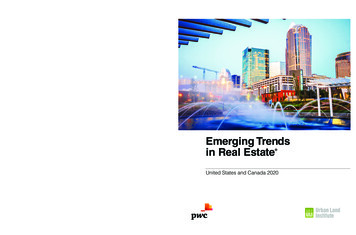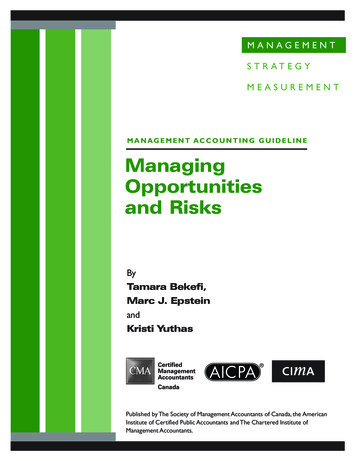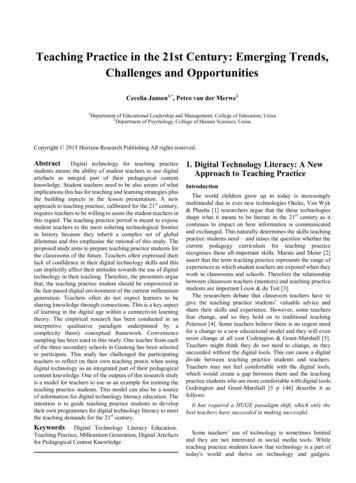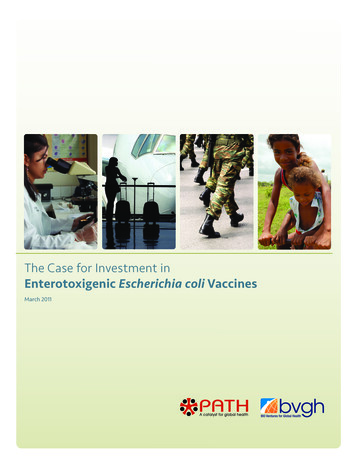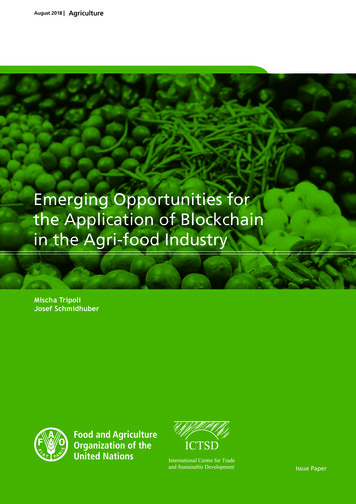
Transcription
August 2018 AgricultureEmerging Opportunities forthe Application of Blockchainin the Agri-food IndustryMischa TripoliJosef SchmidhuberIssue Paper
August 2018l AgricultureEmerging Opportunities forthe Application of Blockchainin the Agri-food IndustryMischa TripoliEconomist, Trade and Markets Division, FAOJosef SchmidhuberDeputy Director, Trade and Markets Division, FAOIssue Paper
iiPublished byFood and Agriculture Organization of the United NationsandInternational Centre for Trade and Sustainable Development (ICTSD)International Environment House 27 Chemin de Balexert, 1219 Geneva, SwitzerlandTel: 41 22 917 8492Fax: 41 22 917 8093ictsd@ictsd.ch www.ictsd.orgPublisher and Chief Executive:Senior Programme Manager, Agriculture:Ricardo Meléndez-OrtizJonathan HepburnCitation: Tripoli, M. & Schmidhuber, J. 2018. Emerging Opportunities for the Application ofBlockchain in the Agri-food Industry. FAO and ICTSD: Rome and Geneva. Licence: CC BY-NC-SA3.0 IGOThe designations employed and the presentation of material in this information product donot imply the expression of any opinion whatsoever on the part of the Food and AgricultureOrganization of the United Nations (FAO) or International Centre for Trade and SustainableDevelopment (ICTSD) concerning the legal or development status of any country, territory, cityor area or of its authorities, or concerning the delimitation of its frontiers or boundaries. Themention of specific companies or products of manufacturers, whether or not these have beenpatented, does not imply that these have been endorsed or recommended by FAO or ICTSD inpreference to others of a similar nature that are not mentioned.The views expressed in this information product are those of the authors and do not necessarilyreflect the views or policies of FAO or ICTSD.ISSN 1817-356XCopyright: FAO,2018Some rights reserved. This work is made available under the Creative Commons AttributionNonCommercial-ShareAlike 3.0 IGO licence (CC BY-NC-SA 3.0 IGO; igo).AcknowledgementsThe authors would like to acknowledge and thank Christopher Emsden of the Food and AgricultureOrganization for his contributions to this publication. His input and intellectual curiosity haveenriched this paper. Their appreciation is also extended to the ICTSD team as well as HeikeBaumüller and Abhishek Sharma involved in the review of this paper.ICTSD is grateful for the generous support from its core donors including the UK Department forInternational Development (DFID); the Swedish International Development Cooperation Agency(SIDA); the Ministry of Foreign Affairs of Denmark (Danida); and the Netherlands DirectorateGeneral of Development Cooperation (DGIS).ICTSD welcomes feedback on this publication. This can be sent to Jonathan Hepburn(jhepburn@ictsd.ch) or to Fabrice Lehmann, ICTSD’s Executive Editor (flehmann@ictsd.ch). Thepaper’s co-author Mischa Tripoli (Mischa.Tripoli@fao.org) can also be contacted.
iiiAgricultureCONTENTSABBREVIATIONSviLIST OF FIGURESivFOREWORDvEXECUTIVE SUMMARYvi1.INTRODUCTION12.UNDERSTANDING DISTRIBUTED LEDGER TECHNOLOGIES33.APPLICATIONS FOR DISTRIBUTED LEDGER TECHNOLOGIESIN THE FOOD AND AGRICULTURE SECTOR63.1Current Trends in the Food and Agriculture Industry63.2Agricultural Supply Chains73.3Land Registries163.4International Agreements Related to Agriculture17PUBLIC POLICY IMPLICATIONS FOR FOOD SECURITYAND RURAL DEVELOPMENT184.5.6.4.1Enhancing Trade Facilitation and Food Security through EfficientInstitutions, Traceability and Market Transparency4.2Strengthening Rural Development Outcomes for Inclusive Economic Growth 1918THE WAY FORWARD FOR DISTRIBUTED LEDGER TECHNOLOGIES215.1Challenges and Risks for Distributed Ledger Technologies215.2The Way Forward for the Public Sector23CONCLUSIONSREFERENCES2527
ivABBREVIATIONSB2Bbusiness-to-businessCCAcentral competent authorityDLTdistributed ledger technologyFAOFood and Agriculture OrganizationIoTInternet of ThingsMSMEmicro-, small- and medium-sized enterpriseOTCover-the-counterRFIDradio frequency identificationSDGSustainable Development GoalSPSsanitary and phytosanitaryTRIPSTrade-Related Aspects of Intellectual Property RightsUNUnited NationsWFPWorld Food ProgrammeWSISWorld Summit for the Information SocietyWTOWorld Trade OrganizationLIST OF FIGURESFigure 1:Traditional centralised ledger and a distributed ledgerFigure 2:Agricultural supply chain on distributed ledger technology
AgricultureFOREWORDDistributed ledger technologies (DLTs) have the potential to transform the global food system byintroducing important efficiency gains along value chains, and improving trust, transparency andtraceability. While large actors are likely to make fast and significant inroads in exploiting DLTs,small farmers and processors also stand to reap significant benefits, provided the technology is madeaccessible to them. This raises the question of how an enabling environment can be created forsmallholders to harness these new technologies, and, at a broader scale, for DLTs, so that thesecontribute to improving the functioning of global food and agricultural markets.This paper, by Mischa Tripoli and Josef Schmidhuber, seeks to make an initial contribution to theemerging public debate on this issue by providing an overview of DLTs and their application in foodand agriculture, examining public policy implications for food security and rural development andidentifying some potential challenges, risks and the way forward.Ricardo Meléndez-Ortiz Boubaker Ben-BelhassenChief Executive, ICTSDDirector, Trade and Markets Division, FAOv
viEXECUTIVE SUMMARYDistributed ledger technologies (DLTs) and smart contracts provide a unique opportunity to bringgreater efficiency, transparency and traceability to the exchange of value and information inthe agriculture sector. This paper aims to facilitate a better understanding of the opportunities,benefits and applications of DLTs in agri-foods. It also identifies technical limits and possibleinstitutional barriers to their adoption.By utilising digital records, cryptography and the disintermediation of transaction processing anddata storage, DLTs can improve both agricultural supply chains and rural development interventionsin a number of ways. First, the ability of the technology to trace a product’s provenance, carrydetailed attributes for the product in each transaction and ensure its authenticity brings vastimprovements in traceability with positive impact on food safety, quality and sustainability.Second, the disintermediation of transactions in agricultural supply chains and the use of smartcontracts enable frictionless and real-time payments for agricultural financial services, which canreduce transaction costs, decrease risk for buyers and sellers and increase cash flow and workingcapital for farmers and sellers which is usually tied up in complex and paper-heavy settlementprocesses. More efficient supply chains and agricultural financial services lead to greater financialinclusion and stronger business development. Third, DLTs allow users to build digital identities withtheir recorded digital and physical assets. The vast amount of data generated from transactions inagricultural supply chains provides more accurate market information and data for supply chainactors and the public sector, which can be used to inform production and marketing decisions,prove a farmer’s track record to access credit and strengthen the enabling environment withbetter informed policies. Physical assets registered on the distributed ledger, such as land titles,can be used as collateral to access financing. DLTs are a secure, fast and immutable method toregister land titles, providing greater legal clarity to land tenure systems.In addition, DLTs also have the potential to improve the implementation and monitoring ofinternational agreements related to agriculture, such as World Trade Organization agreementsand provisions relevant for agriculture, as well as the Paris Agreement on Climate Change. DLTscan bring greater transparency and accountability to compliance with such agreements.There are a number of technical, regulatory, institutional, infrastructure and capacity developmentrelated challenges to be addressed before reaching maturity in order to ensure the scalabilityand accessibility of the technology. Scalability, interoperability and product authenticity throughproduct-process links are important factors for widespread adoption of DLTs in agricultural supplychains. DLTs are not a panacea for the agriculture sector, but the technology provides greatpotential if the challenges for adoption can be overcome.As DLTs continue to develop, the international community has an important role to play incontributing to the creation of an enabling environment that ensures that the productivity gainsgenerated from DLTs can be shared by all market participants, including smallholder farmers,processors as well as micro-, small- and medium-sized enterprises. Governments together withintergovernmental organisations can lead this effort by contributing to technical dialogue onDLTs; providing policy guidance on the use of DLTs in agriculture through intergovernmentalworking groups and multi-stakeholder platforms; developing regulations and standards; enhancingpublic and private partnerships; and providing outreach to improve infrastructure and digitalskills in rural areas. The technology has huge potential to address many of the challenges thatdisadvantaged market players face by allowing them to participate in integrated supply chains,in addition to improving rural development interventions and being an impetus to achieve theSustainable Development Goals.
Agriculture1. INTRODUCTIONAll around the globe, regardless of the level ofeconomic development, humans are constantlytransferring value. The transfer of value is afundamental human activity enabling peopleto trade goods and services, and accumulateproductive capital and savings for their wellbeing. In order to lower uncertainty duringthe exchange of value, institutions are used toensure trust and mitigate risk between buyersand sellers. The institutions that intermediatethe exchange of value use centralisedelectronic ledgers to track assets and storedata. Since those intermediaries often rely onmanual inputs and may be vulnerable to fraud,value transfers tend to impose a high cost onbuyers and sellers, which drastically increasesthe burdens of doing business. High transactioncosts are a major deterrent to economicdevelopment. In addition, cash transactions(in both the formal and informal economy)lack traceability, which ultimately hindersthe ability of micro-, small- and medium-sizedenterprises (MSMEs), particularly in developingcountries, to access credit and new marketsand to grow.Distributedledgertechnologies(DLTs)1introduce a new method to accounting forvalue transfers that minimises uncertainty anddisintermediates the exchange of value with adecentralised and shared ledger, functioningas a digital institution of trust. DLTs offer asecure system of recording transactions ina digital database that removes third-partyintermediaries, reduces transaction costs,enables faster and even real-time transactions,assures immutable data entries and providesaccess to the database for all participants inthe network. After being first introduced asthe electronic cash system for Bitcoin2 in 2008,blockchain and other DLTs have demonstratedenormous potential to enhance efficiency,transparency and traceability across the globaleconomy. DLTs can be programmed to recordnot just economic transactions, but also othertypes of information that is of value andimportance to humankind, such as: birth anddeath certificates, marriage licenses, deedsand titles of ownership, educational degrees oranything else that can be represented in code(Tapscott and Tapscott 2016).Throughout the global economy, governments,private institutions and technology startups are exploring the possible applicationsfor DLTs. Over the last four years, more thanUS 5 billion have been invested in thesetechnologies (CoinDesk 2018). The financialservices sector is one major area where thetechnology is being tested and implemented forpayments and trading securities. Blockchainbased payments have considerable potentialnot only for retail banking, but also foragricultural value chains and the developmentsector in cash-based assistance schemes,remittances and procurement. For example,the World Food Programme (WFP) piloted cashtransfers programmes using a blockchain-basedtechnology to record supermarket transactionsin a Syrian refugee camp. The pilot programmeswere believed to provide substantial financialsavings for WFP, by eliminating financialintermediaries, their associated transactionfees and the time spent by WFP accountantson compiling data and reports from banksand stores, which is no longer needed withautomated record-keeping from the blockchain(Bacchi 2017). The potential applications of DLTsto simplify workflows and improve efficiency inthe development industry are enormous. Theprivate sector is already partnering with theUnited Nations (UN) to explore applications1For the purpose of this paper, the terms distributed ledger technologies (DLTs) and blockchain are interchangeable.It is important to note that blockchain has become a colloquial name for all types of DLTs. However, blockchain isactually one type of DLT. See section 2 for a further explanation.2Bitcoin is a digital currency that uses the DLT called blockchain to transfer funds between parties without a centralauthority.1
2to improve the effectiveness of its work andstrengthen efficiency in the UN system (Bacchi2017).The agricultural sector is no different. Thereare numerous transparency and efficiencyissues in agricultural supply chains, whichultimately put farmers and consumers at adisadvantage. Transactions in agriculturalsupply chains are inherently risky and complex,thus relying on a number of intermediaries;while more conscious consumers have poortransparency on where their food comesfrom and how it is produced. Ultimately,strengthening the linkages between farms,markets and consumers can generate greaterincome growth and job creation (FAO 2017).The potential for DLTs to increase efficiency,transparency and trust throughout agriculturalsupply chains and empower all market playersis real. The technology has the potential tosimplify and integrate agricultural supplychains, enhance food safety, reduce risk intrade finance and promote inclusive trade,increase access to agricultural financialservices, generate smarter market informationand provide greater legal certainty toland-tenure systems. The agri-food andtechnology industries are already exploringsuch applications. In fact, a consortiumof major food companies (Dole, Driscoll,Golden State Foods, Kroger, McCormick andCompany, Nestlé, Tyson Foods and Walmart)are collaborating with IBM to use distributedledger solutions to make their food supplychains more transparent, more traceable andto streamline payments. Previously, IBM andWalmart used blockchain-based technologiesto track a package of mangoes along its exactpath from retail shelf to farm in a matterof seconds (Wass 2017b). This paper aimsto facilitate a better understanding of theopportunities, benefits and applications ofDLTs in the agriculture sector. It also identifiestechnical and financial constraints in adoptingthe DLTs in food and agriculture.
Agriculture2. UNDERSTANDING DISTRIBUTED LEDGER TECHNOLOGIESDistributed ledger technologies are an evolvingtechnology and transaction system that hasmany applications. It was first introduced as thecryptocurrency system for Bitcoin in 2008.3 DLTscan be used to make all types of transactions andstore any type of data and information of value.A DLT is a digital database that uses cryptographyto link and secure transactions or data entries,and disintermediates data processing and datastorage with a peer-to-peer distributed networkof computers that are used to validate and storethe transaction history and information. DLTsfunction as a decentralised digital institution toensure trust between buyers and sellers or users,thus providing an improved method to accountfor value transfers.The technology has three key features thatare necessary to understand (see figure 1).First, DLTs disintermediate the processing andstorage of data entries. Currently, institutionsensure trust through intermediation, where theycontract, clear, settle and record transactionsin a centralised ledger. These intermediariesoften rely on manual inputs and are susceptibleto error and fraud, making the execution oftransactions timely and costly. In addition, thecentralised model limits access to data andcontrol of it for buyers and sellers. DLTs donot use any centralised certifying authorities.Instead, when information is verified on thedistributed ledger, it is instantly recorded on allof the participating computers on the network,which ensures every user has access to up-to-dateinformation; there is no single point of failureand no single institution or actor can control theinformation. DLTs verify transactions by usinga consensus mechanism to reach agreementbetween the participants on the status of a datain the network. The consensus mechanism usesvalidators (who are also participants), economicincentives and consensus algorithms to validatetransactions or data entries in the shared ledger.All users of the DLT can participate in thevalidation process for transactions. This removesthe need for intermediaries by maintaining theelement of trust, while replacing the currentcentralised data model which drastically changesthe payment-cost structure (Cant et al. 2015).This method of validating data entries offersgreater cost efficiency, with lower fees andfaster transactions.Figure 1: Traditional centralised ledger and a distributed ledgerClearinghouseCentralised ledgerDistributed ledgerSource: Author3There is a spectrum of DLTs, each with a different degree of decentralisation. It ranges from permissionless ledgers(like the Bitcoin blockchain) that are censorship resistant, do not have any legal accountability and where users haveequal rights to permissioned ledgers that are censored, have legal liability and where users may not have equal rights.3
4Second, DLTs use cryptography to ensureimmutability and security for data entries.Each data entry is recorded with a timestampand a cryptographic fingerprint of that record,called a hash, that links each record to oneanother, and is then stored securely acrossthe distributed network of computers. Hashesare the basis of security and immutability fordistributed ledgers, which make it impossibleto modify an entry without noticeably affectingall of the entries in the ledger. This makesfraudulent activity in the distributed ledgerimmediately visible to all of the other users.Third, the immutability of records and thedisintermediation of data storage, througha shared ledger, make every transaction orrecord in a distributed ledger traceable andtransparent. In theory, all participants ofthe distributed ledger have access to the fulltransaction history registered on the database.Depending on the purpose and the rules of theDLT, users have the ability to control whichtypes of transaction details are shared, andwith whom. The information stored on theledger is protected by encryption and managedwith private and public keys.4 Together, thesekeys allow users to protect and control who canaccess their information on DLTs and when. Forexample, if a farmer wants to share their credithistory that is registered on the distributedledger with a lender such as a bank, then theycould use the bank’s public key to encrypt andsend the data to the bank; the bank woulduse its corresponding private key to decryptand read the information. In addition, the bankcould verify that the data actually belongs tothe farmer by using the farmer’s public key.Ultimately, access to data in the DLT can beshared or private, depending on the rules ofthe DLT (which are based on the purpose of theplatform) and the users’ choices.Currently, there are two main types of DLTs:public and private (Jayachandran 2017). Apublic DLT is an open ledger with permissionlessaccess, where actors in the network areanonymous and do not need to have anyprevious relationship with the ledger. Publicor permissionless DLTs are censor-proof andfully decentralised systems. Participation inthe network is open to anyone in the world,which means anyone can make transactions,view the ledger’s entire transaction history andparticipate in the consensus mechanism. Theadvantage of public DLTs is that no individualor entity is able to control the information onthe ledger and, therefore, the system is neutral.The two most well-known public DLTs are theBitcoin blockchain and Ethereum; the latter isa generalised transaction ledger that allowsanyone to programme decentralised softwareapplications using smart contracts and executesthem on its DLT. The disadvantage of public DLTsis that there may be some malicious actors in thenetwork, since the participants are unknown.Therefore, there may be applications wheresome types of information are too sensitive tobe shared in a fully open ledger, such as forfinancial institutions.A private DLT is a closed ledger with permissioned access, where users are identifiedand transactions are validated and processedby actors that are already known by theledger. By requiring the identity of actorsto be known in the private or permissioneddistributed ledger, there is an additionallayer of security that limits maliciousactors, as they can be penalised and ejectedfrom the network.5 Instead of anonymousparticipants, permissioned distributed ledgersuse already authenticated legal entities tovalidate transactions (Swanson 2015). Usingauthenticated validators to provide consensusin the network does not mean they can controlthe approval of transactions. In fact, there is atrade-off for permissioned distributed ledgerswhere censorship-resistance is sacrificed forlegal accountability, while still operatingwithout intermediaries. It is precisely thelegal accountability that makes permissioned4In asymmetric encryption, each user has a private and public key that correspond to one another. The private key isconfidential and similar to a password. The public key is like an email address and is available to users in the network.5For more details on the benefits of permissioned distributed ledgers, see Swanson (2015).
Agriculturedistributed ledgers more attractive for globalcapital markets, tangible assets, supply chainsand smart contracts (Swanson 2015).The anonymity of participants in public DLTsand the identity of users in private DLTs makethe process for verifying the transactionsquite different in open and closed systems.There are many different types of consensusalgorithms that are used for public and privateDLTs. Each algorithm has advantages anddisadvantages, which should be understoodand used according to the specific application.For example, one of the best-known public DLTsis the Bitcoin blockchain, which uses a consensusalgorithm called proof-of-work. The proof-ofwork algorithm is costly in terms of resources andtime, and therefore is not an optimal consensusmechanism for business blockchain networks(Hyperledger 2017). The Ethereum public DLTis transitioning to the proof-of-stake algorithm,which is more efficient as it eliminates miningand the expensive computational resourcesused in the proof-of-work algorithm. PrivateDLTs employ two main groups of consensusalgorithms: lottery-based and voting-based.Lottery-based algorithms are advantageous interms of scalability but result in a longer timeto finality, while voting-based algorithms areadvantageous in terms of speed and finality butlack scalability (Hyperledger 2017).Another potential efficiency gain for the globaleconomy is the ability of DLTs to implementsmart contracts. Commerce operates throughcontractual agreements, which are usuallyin the form of physical contracts. Physicalcontracts depend on centralised authoritiesto clear and settle transactions, which arecostly, time consuming and plagued by errorand fraud. Since DLTs have a high degree ofsecurity and immutability, they provide a soundtechnological platform for smart contracts.Smart contracts are computer programsthat automatically execute when predefinedconditions are met. Smart contracts aredesigned to automate much of the contractualprocess. The performance, monitoring andenforcement of contractual agreements aredone autonomously, without any centralauthority or human involvement. Contractautomation could provide huge savings forbusinesses in transaction fees and legal costs,while meeting contractual obligations in realtime (Shadab 2014; Cant et al. 2016). Theseefficiency gains have the potential to uprootthe traditional contractual infrastructureand eliminate the need for centralisedintermediaries.The areas for potential applications of distributed ledgers are immense. The efficiencygains from executing transactions andcontracts through distributed ledgers havehuge implications for the financial industry, butalso for other sectors throughout the economy.Seemingly every sector of the economy istrying to understand how this technology isapplicable and could be beneficial, and whatthe challenges for implementing it are.5
63. APPLICATIONS FOR DISTRIBUTED LEDGER TECHNOLOGIES IN THEFOOD AND AGRICULTURE SECTOR3.1. Current Trends in the Food andAgriculture IndustrySimilar to other sectors of the economy,agriculture and transactions in agriculturalsupply chains have never fully undergone adigital transformation. World agriculture isfacing numerous challenges. The agri-foodindustry must: meet the food demands of a growingpopulation; adjust to changing consumer preferencesin low- and middle-income countries fromcereal-based products towards higherconsumption of animal, fruit and vegetableproducts; promote more environmentally sustainableagricultural practices and decrease environmental footprints; reduce supply chain costs; maintain high-quality sanitary and phytosanitary (SPS) standards; sustain profitable farming operations; and raise incomes of small-scale food producers.Globally, the agriculture sector is a majorsource of employment, which absorbs roughly30 percent of the global workforce (WorldBank 2018b). For many low- and lower-middleincome countries, the sector is an importantsource of income for the rural populations anda major driver of economic growth.Food systems and agricultural practices aroundthe world are diverse and range from modern,large-scale distribution systems channels totraditional food chains. Agriculture in low- andlower-middle income countries is characterisedby a majority of small farms, with three quartersand two thirds, respectively, of all farmlandmanaged in farms of less than five hectares(FAO 2014). In these regions, agriculture ismarked by low labour productivity and lowcapital intensity. This is in stark contrast withthe predominantly large-scale farming in highand upper-middle income countries, typicallycharacterised by high labour productivity andhigh capital intensity.Globally, both food production and retailchannels are changing. There is a growingreliance on global supply chains andlarge-scale distribution systems, such assupermarkets. Food systems are becomingmore capital-intensive, vertically integratedand concentrated in fewer hands. In someinstances, there is the integration of primaryproduction, processing and distribution; theautomation of large-scale processing; andhigher capital and knowledge intensities (FAO2017). For low- and middle income countries,the changing agri-food value chains increasebarriers for small-scale producers and agroprocessors to participate in local, national andglobal markets. Many small-scale operatorsstruggle to participate in integrated valuechains, due to the lack of access to financing,issues of market accessibility and transport,and of complying with the range of standardson quality, traceability and certification (FAO2017). By strengthening the linkages betweenfarmers, markets and consumers, agriculturalvalue chains can generate greater incomegrowth and job creation.Agricultural supply chains are risky andcomplex, as agricultural production dependson difficult-to-control factors (weather, pestsand diseases), agricultural supply chains lacktraceability and the settlement of transactionsis slow and often labour-intensive. Transactionsin agricultural supply chains are overrun withintermediaries and dogged by inefficiencies,while the actors that are able to consistentlyaccess global supply channels are often largescale producers and agro-processors with astrong reputation. Agricultural supply chainsneed more inclusivity for disadvantaged market
Agricultureplayers, in order to boost their economicdevelopment and contribute to the demand forgreater food supplies by a growing population.DLTs have the ability to reduce risk andincrease efficiency in the agri-food industry byproviding transparency and traceability and byeliminating intermediaries in agricultural valuechains. In addition, by reducing uncertainty andenabling trust among market players, DLTs andsmart contracts also provide a real opportunityfor more inclusive market participation forsmallholders and MSMEs.3.2. Agricultural Supply Chains3.2.1 Agricultural supply chains managementAgricultural supply chains have substantialinefficiencies, which impact all actors inthe chain from producers to consumers. It isestimated that the cost of operating supplychains makes up two thirds of the final costof goods (Niforos 2017b), while seven percentof the global value of trade is absorbed by thecosts of documents alone.6 The challenges forsupply chains include: the lack of transparenc
This paper aims to facilitate a better understanding of the opportunities, benefitsand applications of DLTs in agri-foods. It also identifiestechnical limits and possible . pdf. Blockchain , , Emerging opportunities for the applica



